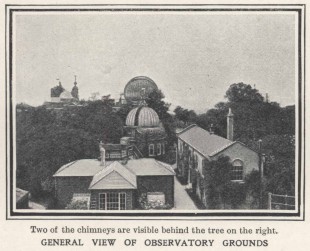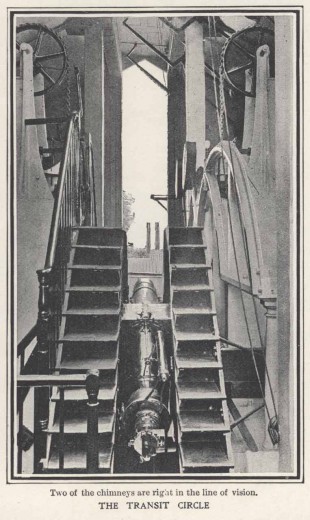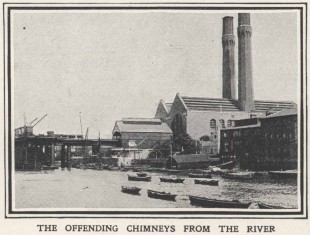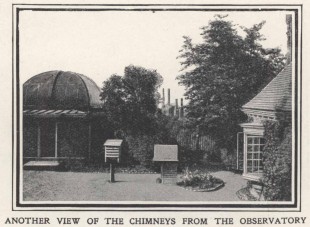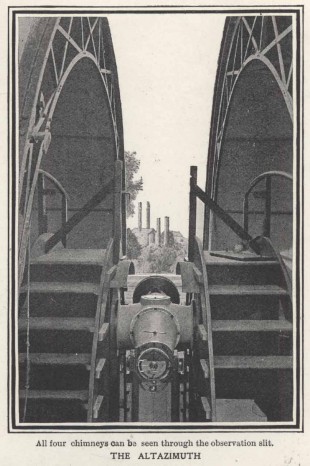…where east meets west
- Home
- Brief History
- The Greenwich Meridian
- Greenwich
(1675–1958) - Herstmonceux
(1948–1990) - Cambridge
(1990–1998) - Outstations (1822–1971)…
- – Chingford (1822–1924)
- – Deal
(1864–1927) - – Abinger
(1923–1957) - – Bristol & Bradford on Avon
(1939–1948) - – Bath
(1939–1949) - – Hartland
(1955–1967) - – Cape of Good Hope
(1959–1971)
- Administration…
- – Funding
- – Governance
- – Inventories
- – Pay
- – Regulations
- – Royal Warrants
- Contemporary Accounts
- People
- Publications
- Science
- Technology
- Telescopes
- Chronometers
- Clocks & Time
- Board of Longitude
- Libraries & Archives
- Visit
- Search
Contemporary Account – The Menace to the Meridian
| Date: | 1906 |
| Author: | ESG |
| Title: | The Menace to the Meridian, Greenwich Observatory and the LCC |
| About: | Published in The Graphic on 23 June, 1906, p.809, this article covers the storm that blew up when the Observatory finally woke up to the fact that Greenwich Power Station was being constructed a short distance away on the line of the Meridian |
| Images: | Five |
THE MENACE TO THE MERIDIAN
GREENWICH OBSERVATORY AND THE LCC.
There is one view in London that would redeem the capital of the Empire for ever, if redemption were necessary, of the charge of ugliness which is sometimes levelled against it. It is the view across the Thames, in Greenwich Reach, of the Naval Hospital that Wren built as his masterpiece, with Greenwich Hill and the Observatory, founded by Charles II., behind it. So large is London that, though thousands of Londoners see this beautiful sight every day of their lives, there are millions of others who see it, perhaps, no oftener than once in ten or twenty years; and that is the reason, one must suppose, why its beauty is permitted to be disfigured without a word of protest. For disfigured it is, irretrievably, by the new power station of the London County Council, which has been built a few hundred yards distant from the Naval Hospital, and due north of the Royal Observatory. The power station is a building which is truly hideous. Architecturally it has not a redeeming feature, not even that of a want of ostentation, for its four tall chimneys draw attention to its ugliness. If, however, ugliness were the only vice of this blot on the landscape one would have no choice but to ignore it, and classify it among the other misfortunes of London which want of a proper civic spirit has permitted, such as Ludgate Hill Bridge and Charing Cross Railway Station.
There are, however, far graver objections to the power-house than merely aesthetic ones. Of the four chimneys two are 250 feet high; the remaining two are to be of the same height; and all four consequently tower above the telescope domes of the, Royal Observatory, despite the 150 feet elevation of Greenwich Hill. Two of the chimneys, the two which are completed, are directly on the line of the meridian which passes through Greenwich Observatory round the world. Consequently, an observer in the dome which shelters the transit telescope, when he looks through the slit through which the telescope points, finds the two chimneys right in his line of vision. Even when no smoke comes from the chimneys, there is always the tremulous quiver arising from the heated gases; and, therefore, we need scarcely point out that observations made by the transit telescope are very seriously hampered and prejudiced. The transit telescope has for sixty years been employed in making observations of the moon as it crosses the meridian; and on the microscopically exact nature of the determinations thus made, depend the exactness of charts which affect the interests and safety of navigation not only of the British Navy and of the British Mercantile Marine, but of the world's navies and shipping. We draw special attention to the continuity of the observations. In science, as Lord Kelvin remarked a few years ago at the opening of the National Physical Laboratories at Bushey, discovery and progress alike rest not on any isolated inspiration or happy stroke of fortune, but on exactness of measurement and precision of determination, so that we may even say that Newton's discovery of the law of gravity was chiefly the outcome of scrupulous and repeated measurement. Thus the long-continued, exact observation of the moon’s movements, of the irregularities of its transits across the spider line of the transit instrument at Greenwich derive value from their continuity. They accumulate value as the years go on, because being made always with the same instrument, with the same equation of error, under exactly the same conditions, they are related always to the same standard. Any break in the continuity of the observations, any transference of the instrument or the observations to another spot, forces science to begin again with a new standard, and deprives astronomy of the increasing value of the observations continually made. The transit instrument on the meridian of Greenwich is not the only one employed in observing the moon. During the earlier part of the lunar month the moon is on the meridian in the day-time, and it then becomes necessary to time and observe its movements at times when it is not on the meridian. For this purpose the altazimuth is used. By a deplorable coincidence, the new chimneys which are now being built adjoining the main building of the County Council power-house, lie in the slit of the dome of the altazimuth, in just the same way that those already built lie on the meridian, and will obscure observations in a precisely similar way.
Nor is this all. So far we have spoken only of observations, of which the practical value is so apparent that hardly an elementary knowledge of astronomy or of navigation is needed to comprehend it. But Greenwich Observatory has other work to do, in the interests of pure science, in common with the other great observatories of the world, which in Germany, in France, in Russia, in Italy, in the United States, in Denmark, and, in fact, in all the chief countries of the world, receive every assistance and encouragement from their Governments in doing the work for which the observatories were founded. One of the tasks which the world's observatories share in common is that of making the great atlas of the 150,000,000 stars of the visible universe. Greenwich Observatory's share in this work embraces the circumpolar stars; and it needs no scientific education to perceive the exactness and precision which is demanded in this kind of observation. But the testimony of the Astronomer-Royal and of Professor Turner, Savilian Professor at Oxford, is decisive on the disturbance to this class of work which is inflicted by the vibration of the dynamos of the power-house. We may very briefly explain why. For many observations it is necessary to have a reflecting surface of quicksilver. Vibrations of the kind set up by a Power Station, though they are imperceptible to the ordinary sensibility, are sufficient to disturb quicksilver surfaces and cover them with minute ripples. These ripples, according to Professor Turner's evidence, are a grave disturbance to accuracy of observation, and will be still more seriously disturbing when the power station is finished and has all its engines running.
Enough has been said to show that there are many scientific reasons why the power station contributes a serious threat to the efficiency of an institution which is neither parochial nor metropolitan, nor even merely national. Greenwich Observatory belongs to the whole world; its standard is one on which the world’s astronomy, one might say the world’s geodesy, relies. It is, besides, a historical monument of the greatest interest; and quite apart from these reasons its accessibility to the chief port of England, of Europe, and, indeed, of the world, make it extremely undesirous, in the interests of navigation, and of all the ships which send their chronometers there, that it should be moved. Its work could not be done elsewhere, and there is no reason why any attempt should be made to transfer it. E. S. G.
© 2014 – 2025 Graham Dolan
Except where indicated, all text and images are the copyright of Graham Dolan
